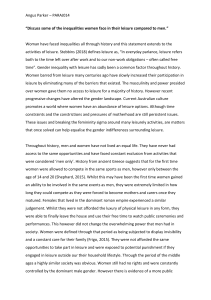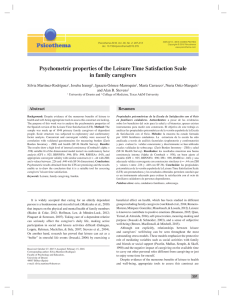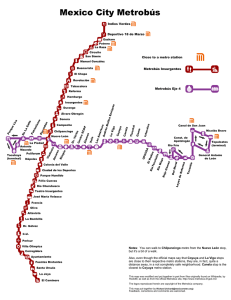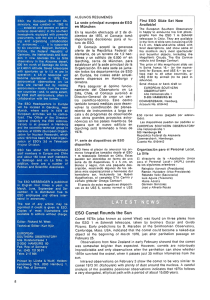Demand of sports and leisure for youth in the city of Novo Hamburgo
Anuncio
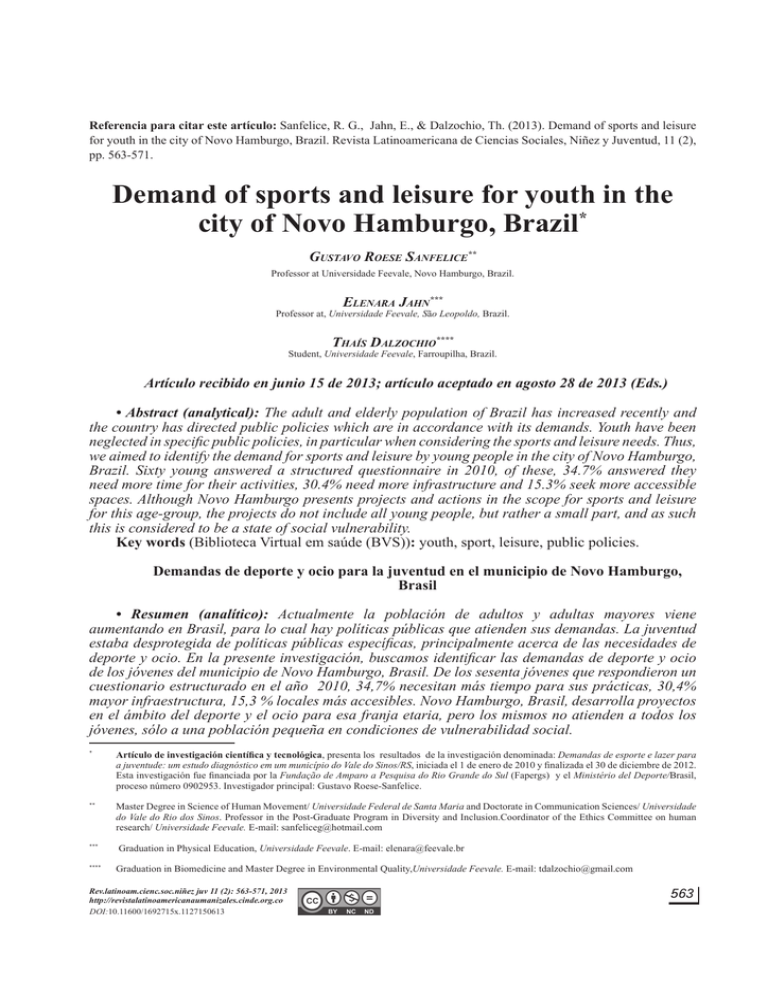
DEMAND OF SPORTS AND LEISURE FOR YOUTH IN THE CITY OF NOVO HAMBURGO, BRAZIL Referencia para citar este artículo: Sanfelice, R. G., Jahn, E., & Dalzochio, Th. (2013). Demand of sports and leisure for youth in the city of Novo Hamburgo, Brazil. Revista Latinoamericana de Ciencias Sociales, Niñez y Juventud, 11 (2), pp. 563-571. Demand of sports and leisure for youth in the city of Novo Hamburgo, Brazil* GUSTAVO ROESE SANFELICE** Professor at Universidade Feevale, Novo Hamburgo, Brazil. ELENARA JAHN*** Professor at, Universidade Feevale, São Leopoldo, Brazil. THAÍS DALZOCHIO**** Student, Universidade Feevale, Farroupilha, Brazil. Artículo recibido en junio 15 de 2013; artículo aceptado en agosto 28 de 2013 (Eds.) $EVWUDFWDQDO\WLFDOThe adult and elderly population of Brazil has increased recently and the country has directed public policies which are in accordance with its demands. Youth have been QHJOHFWHGLQVSHFL¿FSXEOLFSROLFLHVLQSDUWLFXODUZKHQFRQVLGHULQJWKHVSRUWVDQGOHLVXUHQHHGV7KXV we aimed to identify the demand for sports and leisure by young people in the city of Novo Hamburgo, Brazil. Sixty young answered a structured questionnaire in 2010, of these, 34.7% answered they need more time for their activities, 30.4% need more infrastructure and 15.3% seek more accessible spaces. Although Novo Hamburgo presents projects and actions in the scope for sports and leisure for this age-group, the projects do not include all young people, but rather a small part, and as such this is considered to be a state of social vulnerability. Key words (Biblioteca Virtual em saúde (BVS)): youth, sport, leisure, public policies. Demandas de deporte y ocio para la juventud en el municipio de Novo Hamburgo, Brasil 5HVXPHQ DQDOtWLFR Actualmente la población de adultos y adultas mayores viene aumentando en Brasil, para lo cual hay políticas públicas que atienden sus demandas. La juventud HVWDEDGHVSURWHJLGDGHSROtWLFDVS~EOLFDVHVSHFt¿FDVSULQFLSDOPHQWHDFHUFDGHODVQHFHVLGDGHVGH GHSRUWH\RFLR(QODSUHVHQWHLQYHVWLJDFLyQEXVFDPRVLGHQWL¿FDUODVGHPDQGDVGHGHSRUWH\RFLR de los jóvenes del municipio de Novo Hamburgo, Brasil. De los sesenta jóvenes que respondieron un cuestionario estructurado en el año 2010, 34,7% necesitan más tiempo para sus prácticas, 30,4% mayor infraestructura, 15,3 % locales más accesibles. Novo Hamburgo, Brasil, desarrolla proyectos en el ámbito del deporte y el ocio para esa franja etaria, pero los mismos no atienden a todos los jóvenes, sólo a una población pequeña en condiciones de vulnerabilidad social. * ** *** **** $UWtFXORGHLQYHVWLJDFLyQFLHQWt¿FD\WHFQROyJLFD, presenta los resultados de la investigación denominada: Demandas de esporte e lazer para a juventude: um estudo diagnóstico em um município do Vale do Sinos/RSLQLFLDGDHOGHHQHURGH\¿QDOL]DGDHOGHGLFLHPEUHGH (VWDLQYHVWLJDFLyQIXH¿QDQFLDGDSRUODFundação de Amparo a Pesquisa do Rio Grande do Sul (Fapergs) y el Ministério del Deporte/Brasil, proceso número 0902953. Investigador principal: Gustavo Roese-Sanfelice. Master Degree in Science of Human Movement/ Universidade Federal de Santa Maria and Doctorate in Communication Sciences/ Universidade do Vale do Rio dos Sinos. Professor in the Post-Graduate Program in Diversity and Inclusion.Coordinator of the Ethics Committee on human research/ Universidade Feevale. E-mail: [email protected] Graduation in Physical Education, Universidade Feevale. E-mail: [email protected] Graduation in Biomedicine and Master Degree in Environmental Quality,Universidade Feevale. E-mail: [email protected] Rev.latinoam.cienc.soc.niñez juv 11 (2): 563-571, 2013 http://revistalatinoamericanaumanizales.cinde.org.co DOI:10.11600/1692715x.1127150613 563 GUSTAVO ROESE SANFELICE - ELENARA JAHN - THAÍS DALZOCHIO Palabras clave (Biblioteca Virtual em saúde (BVS)): juventud, deporte y ocio, políticas públicas. Demandas de esporte e lazer para a juventude no município de Novo Hamburgo/Brasil 5HVXPRDQDOtWLFRAtualmente a população de adultos e idosos vem aumentando e o Brasil apresenta políticas públicas atendendo às suas demandas. A juventude estava negligenciada de SROtWLFDVS~EOLFDVHVSHFt¿FDVSULQFLSDOPHQWHDFHUFDGDVQHFHVVLGDGHVGHHVSRUWHOD]HU$VVLPFRP DSUHVHQWHSHVTXLVDSURFXUDPRVLGHQWL¿FDUDVGHPDQGDVGHHVSRUWHHOD]HUGRVMRYHQVGRPXQLFtSLR de Novo Hamburgo/Brasil. Dos sessenta jovens que responderam um questionário estruturado no ano de 2010, 34,7% responderam que necessitam de mais tempo para suas práticas, 30,4% maior infraestrutura, 15,3 % locais mais acessíveis. Ainda que Novo Hamburgo apresente projetos/ações no âmbito do esporte e lazer para essa faixa etária os mesmos não atendem a todos os jovens, mas sim uma parcela pequena, dita como em estado de vulnerabilidade social. Palavras-chave (Biblioteca Virtual em saúde (BVS)): juventude, esporte e lazer, políticas públicas. -1. Introduction. -2. Methods. -3. Results and discussion. -4. Conclusion. -References. 1. Introduction Although the adult and elderly population has increased in Brazil, in our understanding, the youth deserves great attention, since the constitution of society in the future relies on current investments. Nevertheless, debates concerning youth conceptions and needs are extremely relevant. From these debates, the society organized social actions and public SROLFLHVLQRUGHUWRVHUYHWKLVVSHFL¿FSRSXODWLRQ group. The physical activity is understood as a form of social action which provides the integration of consciousness, language and transformation of the conscious movement. Regarding this perspective, it is important to have habits that contribute to the consolidation of organic potentialities, self-conception, relation and familiarity (González & Tamayo, 2012). ,WPLJKW EH GLI¿FXOW QRZDGD\V WR HVWDEOLVK what juvenile is through attitudes, since habits that were considered only of young people are more and more adopted by people of other ages. Accordingly, an age division of young established by the Conselho Nacional de Juventude (Conjuve, 2006) will be adoptedin this study, considering the period between 15 to 29 years old. In accordance with data from Censo 2010, 564 Brazil has 47 millions of young people in that age division. The researched city, Novo Hamburgo, presents 61.317 (Ibge, 2010). The remaining question is whether there are programs and projects of the government, as well as of the civil society that comprise the needs of anincreasing number of young people in our country. Regarding the discontinuance of actions of the government, focusing on programs in behalf of children and elderly, youth has been devoid RIVSHFL¿FSROLFLHVWRPHHWWKHLUGHPDQGVHYHQ when Conjuve has established priorities for these ages, the policy must be executed. Thus, it is important to know the social demographic SUR¿OH RI \RXQJ SHRSOH EHWZHHQ DQG years old who go to any public place, such as squares, gyms, skate parks, among others, in the city of Novo Hamburgo, RS/Brazil. 7KHUHVHDUFKLVMXVWL¿HGE\WKHLPSRUWDQFH of sports and leisure in the perspective of life quality and social inclusion of citizens and by the pre-eminence of a policy statement related to these practices. Data collected aim to provide WKHUHÀHFWLRQRIJRYHUQPHQWDJHQFLHVDERXWWKH need of formulation of policies. The same way, these subsides might be a pattern for the third sector which invests in social projects. The aim of this study was to identify the demands of sports and leisure of young people in the city of Novo Hamburgo, Brazil. Rev.latinoam.cienc.soc.niñez juv 11 (2): 563-571, 2013 http://revistalatinoamericanaumanizales.cinde.org.co DOI:10.11600/1692715x.1127150613 DEMAND OF SPORTS AND LEISURE FOR YOUTH IN THE CITY OF NOVO HAMBURGO, BRAZIL 2. Methods The research is characterized as descriptive quantitative, having as sample 60 young people aged between 18 and 29 years old, living in Novo Hamburgo, Brazil. For data collection, a structured questionnaire containing 20 open and closed questions was used. Participants included in the research answered the questionnaire after their concordance, based on the free informed consent, where this document explains the research objectives and all the procedures related to the results. People who participated in this research were met downtown, thus SURYLGLQJDGLYHUVL¿FDWLRQRISDUWLFLSDQWVLQWKH UHVHDUFK VLQFH WKHUH LV JUHDW WUDI¿F RI SHRSOH from different neighborhoods. This project was approved by the Institution’s Ethics Committee, under the protocol number 4.09.01.09.1490. The research is in accordance with Brazilian laws on ethic in research with human beings, and it is based on the resolution 196/1996 of the Conselho Nacional de Saúde, Brazil. All data collected were tabulated and presented in percentage and graphics, as described below. qualities and which manifests itself through different forms, according to historic and social characteristics”. Social demographic aspects of young people from the researched city are highlighted, according to age, genre, marital status, education, economic basis, and work (work load). Also, we highlighted relative aspects and young people sports and leisure needs. $V SUHVHQWHG LQ ¿JXUH IURP WKH participant interviewed are in the age of 18 to 20 years, 16% are 21 to 23 years, 24% are 24 to 26 years and 21,3% are 27 to 29 years old. Regarding the genre, 60% of participants were male. Among them, 80% were single, while 20% were married. Concerning work, 91% were working and 9% were not. From all of them, 62,6% were studying, while 37,4% were not attending any classes when the research was performed. 3. Results and discussion For this research, an exploratory and descriptive methodology was performed. A questionnaire with open and closed questions was used, which comprised socioeconomic data and aspects of interest, practice of sports as leisure, the sample included 60 young people aged 18 to 29 years old, both genre, randomly chosen. According to Abramova and Esteves WKH EHVW IRUP WR GH¿QH WKH \RXQJ nowadays, is through characteristics which recognize the existing diversity among young SHRSOHUHÀHFWHGE\GLIIHUHQFHVRIJHQUHDJH social class, ethnicity, place where the person lives, economical conditions, and so on. The existence of several common aspects in youth can be noted. Conjuve (2006) brings this same approach about youth, which presents being \RXQJ DV ³D VRFLDO FRQGLWLRQ ZLWK VSHFL¿F Rev.latinoam.cienc.soc.niñez juv 11 (2): 563-571, 2013 http://revistalatinoamericanaumanizales.cinde.org.co DOI:10.11600/1692715x.1127150613 Figure 1. &RQVLGHULQJWKHVRFLDOGHPRJUDSKLFSUR¿OH characterized, data mentioned above delimitate young people who participated in this research. According to Bourdieu (in Garcia, 2009), the youth supported by the parents in the condition of students with great time available which can EH¿OOHGZLWKOHLVXUHDQGVFKHGXOHGVSRUWVZLWK access to cultural privileges which requires greater economical power and even a cultural inherited is treated as immature. These young see the world and live along with it in the margin of these class conditions, whether accepting the greater control of adult generations, whether resisting to it. Data have demonstrated that young people start working earlier and earlier, searching for 565 GUSTAVO ROESE SANFELICE - ELENARA JAHN - THAÍS DALZOCHIO assuming their own responsibilities. In the past years there was an increase in the number of young people who attend schools, therefore it is reported the most part of them do not stay only in the school environment. It is considered by many of them, that their own work allows them access to knowledge and learning, besides ¿QDQFLDOLQGHSHQGHQFHHYHQLWLVQRWDIDPLOLDU need. Thus, free time available of young people who only study, as presented by the author above, does not occur with most participants of this research, since they study and work at the same time, obtaining less time available for leisure. A large number of researchers and managers claim it is fundamental to put off the entry in the labor market to allow these young people, above all, permanence in school and to graduate, aiming better jobs, in terms of payment and possibility of personal satisfaction (Andrade, 2008). As discussed in studies and cited previously, the permanence in schools without the need of working is not part of the reality of these young, DV REVHUYHG WKH ZHHNO\ ZRUNORDG LQ ¿JXUH The research presents that approximately 65% of the young people have a workload of 40 hours per week, 26% work 30 hours per week, 3% work 20 hours per week, while 6% of participants have other different workloads. Figure 2. Most of these Brazilian young people face severe mechanisms of social selection to support themselves and to study, since many of them conciliate both school and work, while 566 educational institutions do not prepare young people to get in the market work. As represented LQ WKH IROORZLQJ ¿JXUH VHYHUDO \RXQJ SHRSOH who participated in the study, are still in the educational process. Figure 3. $VVKRZQLQ¿JXUHRIWKHSHRSOH are in graduationlevel, while 6,7% have already concluded it. Yet, 18,6% have concluded high school and 14,7% are still attending this level, 4% have basic education, while 6,7% have not completed this level. This public presents the same percentage with basic education incomplete and graduation completed, taking into account that economic levels were not considered, which would be relevant in the type of comparison. Once again, it is observed the need of getting in the work market as a priority in many cases. The divergence between free time and time to study/work correspond to the lack of time for leisure. The need of working earlier and earlier leads young people to have less availability for leisure. Currently, the work market presents less possibilities of social mobility. The fast transformation of work market with few opportunities of well paid productive insertion PDNHGLI¿FXOWWRPDLQWDLQDFWLYLWLHVRIVWXG\DQG leisure, which makes estate polities even more important in this context (Castro & Aquino, 2008). These same authors consider that the young DWWKLVDJHLVKDYLQJKLV¿UVWH[SHULHQFHLQZRUN market, it would be “normal” if he attended several jobs as a form to gain knowledge and experience, assuming it would contribute to Rev.latinoam.cienc.soc.niñez juv 11 (2): 563-571, 2013 http://revistalatinoamericanaumanizales.cinde.org.co DOI:10.11600/1692715x.1127150613 DEMAND OF SPORTS AND LEISURE FOR YOUTH IN THE CITY OF NOVO HAMBURGO, BRAZIL his decision of a certain occupation later, with the possibility of having a better distribution of his free time. Conciliating studies and work generates lack of time available, as shown by data previously mentioned. Therefore, young people divide their free time into these activities (study and work), thinking of a future stability, but depriving themselves of enjoying their free time. Sometimes the work practices of these young people are not in accordance with the formal work, but informal, which is confused with leisure, as art and sportive practices. For contemporary society, the young must follow the values and predetermined social goals in his work practice. However, most young people attribute different values to the usual ones, demonstrating their creative talent. $V REVHUYHG LQ ¿JXUH PRVW SDUW RI WKH participants lives in Canudos neighborhood (20%), 14,7% lives in Santo Afonso neighborhood, 13,4% lives downtown, while 51,9% lives in other locals. Figure 4. According to Pais (2006), the appropriation of the neighborhood, its territoriality, is important to identify the young people as a part of that space. Considering this approach of the young to public spaces for leisure practices, many of them leave their neighborhood to work, study and do their leisure activities in other neighborhoods, so they adapt to other public spaces besides their social context. $VGHPRQVWUDWHGE\¿JXUHRI\RXQJ people of Novo Hamburgo practice some sport or perform some leisure activity, while 40% do none of these activities. Rev.latinoam.cienc.soc.niñez juv 11 (2): 563-571, 2013 http://revistalatinoamericanaumanizales.cinde.org.co DOI:10.11600/1692715x.1127150613 Figure 5. Young people are used to emphasize the importance in their lives of being consumers and producers of culture, of having access to leisure spaces and sports (Unesco, 2004). Generally, the amusement places, the types of leisure, the use of free time and the frequency of this use are indispensable indicators of the form of being young […] (Garcia, 2009). It is observed that, although young people are busy with work and school, they develop strategies that allow them to “live” the leisure. Costa and Pires (2006) report that proper spaces for the formation of new groups of familiarity, without severe rules which are imposed by the society, might be seen in moments of leisure. Leisure is a space/time for the development of social relations, in exchange of experiences, whereby young people try to organize new forms of individual or collective identities. It is important to consider that these NQRZOHGJHDFWLYLW\ ¿HOGV FROODERUDWH LQ WKH DI¿UPDWLRQWKDW\RXQJSHRSOHPLJKWFRQWULEXWH to the materialization of a culture of peace (Unesco, 2004). Nevertheless, Unesco observes that indicators about cultural equipments justify and reinforce the concern about the lack of leisure and culture spaces for the young SRSXODWLRQFKLHÀ\IRUWKHSRRURQHV Several factors complicate the youth’s access to sports. Besides clubs, other alternatives are virtually nonexistent. Public programs such as Pelc (Programa de Esporte e Lazer na Cidade) serves a plausible number of young people (estimated in 1.000 young people), functions more in education, recreation 567 GUSTAVO ROESE SANFELICE - ELENARA JAHN - THAÍS DALZOCHIO and leisure in sports, and the responsibility of encouraging the participation of young people in such activities is of private entities (Ministério do Esporte, 2008). instead of the use of public ones, differing from the adequacy of public leisure spaces to serve the population. According to Conjuve, in the past two years, the construction of the National Youth Policy expanded the visibility of the theme in the public scenario. In this period, the government has implemented and improving services, programs, projects and actions in different ministries, guided by the paradigms which consider young people as subjects of rights and important for the national development. Figure 6. Data from this study demonstrate that 65,8% of activities in Novo Hamburgo/RS are offered by private entities, while 17% and 4% are offered by the local government and federal government, respectively. Spaces provided by other proponents are used by 12,3% of the LQWHUYLHZHGSHRSOH¿JXUH Existing public policies and social projects in Novo Hamburgo are activities funded actively by the Sport Minister, as the Pelc (Programa de Esporte e Lazer da Cidade), which acts as a social policy the assures the access to the recreative sport and leisure, representing the federal government’s offer to the practice of activities in leisure moments. The “youth policies” associate the aspects of social protection to the ones which provide development opportunities: they aim theguarantee of protection related to several situations of vulnerability and social risk which H[LVWIRUWKH\RXQJDQGDOVRWKH\VHHNWRSURYLGH opportunities of experience and multiple social insertion, which favors the social integration of the young people in several layers of social life. If this search for suppress social vulnerability situation exists, fails in the system occur, since there is a prevalence of the use of private spaces 568 Figure 7. Activities of interest of young people are VKRZQLQ¿JXUHZKLFKVRFFHUDQGYROOH\EDOO are the most practiced ones, 24% and 18,6% respectively. Interest in performing some type of physical activity in free time was demonstrated by 92%, while other subjects reported no interest in physical activities. Our data demonstrating soccer as the top sport searched by the young people corroborates with the study performed by Martinez et al. (2012). Leisure contents may be the varied and in order an activity might be understood as leisure, it is necessary it serves some values related to time and attitude aspects (Marcellino, 2006). These data show young people still search the sports as leisure, and mainly sports know worldwide, such as soccer and volleyball. These activities are contemplated in the Pelc in the city, as evidenced previously. Therefore, the popularization of certain activities might limit other cultural leisure activities. Rev.latinoam.cienc.soc.niñez juv 11 (2): 563-571, 2013 http://revistalatinoamericanaumanizales.cinde.org.co DOI:10.11600/1692715x.1127150613 DEMAND OF SPORTS AND LEISURE FOR YOUTH IN THE CITY OF NOVO HAMBURGO, BRAZIL Figure 8. Factors which lead the young people to quit the physical activities practice are lack of time available, and need of a better infrastructure, 34,7% and 30,4% respectively, as shown in ¿JXUH <RXQJ SHRSOH UHFRJQL]H WKH QHHG of the practice, but they also claim for more accessible locals and more incentives from the government. Figure 10. $FFRUGLQJ WR ¿JXUH RI \RXQJ people still do not know the infrastructure provided by the city to practice sports. Among them, 21,7% knows squares, 15% knows parks, 6,7% knows courts and 11,6% knows other structures for sports and leisure. In order to overcome this lack of structure, people should search for what is closer to them and more familiar. This familiarity is essential for the cities’ excellence (Saldanha-Filho, 2003). 4. Conclusion Figure 9. The most searched places by the young SHRSOH WR SHUIRUP DFWLYLWLHV DUH VWLOO ¿WQHVV centers (31,6%), while 26,9% prefer gyms and courts, considering that these areas provide the practice of activities indoors. Clubs and schools were cited (12,2% and 7,4%, respectively). Therefore, 12,2% choose to practice their DFWLYLWLHV VXFK DV ZDONLQJV RXWGRRUV ¿J 8). Performing any leisure activity involves satisfaction of the people (Marcellino, 2006). Rev.latinoam.cienc.soc.niñez juv 11 (2): 563-571, 2013 http://revistalatinoamericanaumanizales.cinde.org.co DOI:10.11600/1692715x.1127150613 ,QWKLVUHVHDUFKWKHSUR¿OHRI\RXQJSHRSOH who work and study was delineated, showing that performing any type of physical activity is GLI¿FXOWIRUODFNRIWLPHRUOD]LQHVV7KHQHHG of getting into the work market and always be updated are characteristics which describe the \RXQJSHRSOH¶VSUR¿OHLQ1RYR+DPEXUJR Although active public policies are satisfactory for the young people’s need, free time is necessary. The no practice of leisure is the result of lack of time, which leads to the GHPDQGLQJ IRU PRUH HI¿FLHQW SXEOLF SROLFLHV that serve properly the young people, regarding leisure. Currently, it is known that the government’s function is to provide the society’s welfare, through the development of a series of actions and acting directly in different areas such as health, education and environment. In order to achieve satisfactory results in several areas and provide the society’s welfare, the government XVHVSXEOLFSROLFLHVZKLFKPD\EHGH¿QHGDV the totality of actions, goals and plans that the national, state and local government delineate 569 GUSTAVO ROESE SANFELICE - ELENARA JAHN - THAÍS DALZOCHIO to achieve the populations welfare and the public interest. Even though Novo Hamburgo presents projects/actions in sports and leisure activities (Pelc) for young people at this age, it does not serve all young people, but a very small part, which isconsidered to be in a state of social vulnerability. Little integration among the existing services or goals which they try to reach is noted. Besides, the existing actions DUHLQVXI¿FLHQWLQDSSURSULDWHRULQHIIHFWLYHWR serve this population. Although the population of adults and elderly is increasing in our country, the youth, in our understanding, deserves attention, since the constitution of society tomorrow depends on current investments. The actions directed to childhood and youth of popular groups, particularly those in situation of greater vulnerability, require a great number of projects directed to that population, developed, mostly, by nongovernmental organizations, since advances in defense of the young population are recent (Silva & Lopes, 2009). Public policies directed to these young SHRSOH HYHQ UHFHQW GR QRW H[SDQG HI¿FLHQWO\ the idea of appropriation of the young people, regarding public spaces to perform physical activities. So, there is a search for private spaces since they are better conserved and safer, while public spaces are set aside. The lack of public programs of sports and leisure has enabled the appearance of isolated actions of society. The few existing actions are basically under the private responsibility. Therefore, there has been an expansion of FOXEVJ\PV¿WQHVVFHQWHUVDQGVRIRUWKZKLFK should be paid in order to be used, while public spaces have been inappropriate and target of vandalism. 4XDOL¿FDWLRQUHVWUXFWXUDWLRQDQGH[SDQVLRQ of these public spaces must be guaranteed and it is through social rights that people may reach for social equality. Community’s participation is essential to recognize the value of public spaces available for sports and leisure, since they aim different people can interact and establish relations, whether social or personal. We realize that youth needs spaces which provide leisure, where they will not be only 570 spectators, but that they also can be in action, this way requiring proper leisure equipments. Furthermore, there is little articulation of social that give attention to the sports and leisure’ use in order to reach young people of all social classes, FKLHÀ\WKHPRVWYXOQHUDEOHRQHV%HFNHUHWDO 2010). Nevertheless, an appropriation of these spaces by the community is required. References Abramova, M., & Esteves, L. C. G. (2007). Juventude, Juventudes: pelos outros e por elas mesmas. In M. Abromavay, E. R. Andrade & L. C. G. Esteves. Brasília: Ministério da Educação, Unesco. Andrade, C. C. (2008). Juventude e trabalho: alguns aspectos do cenário brasileiro contemporâneo. Brasília: Instituto de Pesquisa Econômica Aplicada-Ipea. Becker, A. R., Jahn, E. & Neves, V. A. (2010). Mapa de ações de esporte e lazer para a juventude no município de Novo HamburgoRS, Anais do V Congresso Sulbrasileiro de Ciências do Esporte. Uivali-Itajaí-SC 23 a 25 de setembro de 2010. Available in: http://www.rbceonline.org.br/congressos/ index.php/vcsbce/vcsbce/schedConf/ presentations 2010. Cited in: april, 10, 2010. Castro, J. A. & Aquino, L. (2008). Juventude e Políticas Sociais no Brasil. Brasília: Ipea. Conselho Nacional de Juventude-Conjuve (2006). Política Nacional de Juventude: diretrizes e perspectivas. São Paulo: Fundação Friedriech Ebert, Conselho Nacional de Juventude-Conjuve. Costa, A. G. & Pires, G. L. (2006). Moda/ indumentária em culturas juvenis: símbolos de comunicação e formação de identidades corporais provisórias em jovens de ensino médio. 3º Congresso Sulbrasileiro de &LrQFLDVGR(VSRUWH. Santa Maria: 20 a 23/ setembro/2006. Garcia, D. M. F. (2009). Juventude em tempo GH LQFHUWH]DV HQIUHQWDQGR GHVD¿RV QD educação e no trabalho. Belo Horizonte: Fapemig. González, A. M. & Tamayo, O. E. (2012). Obstáculos cognitivo-emotivos para Rev.latinoam.cienc.soc.niñez juv 11 (2): 563-571, 2013 http://revistalatinoamericanaumanizales.cinde.org.co DOI:10.11600/1692715x.1127150613 DEMAND OF SPORTS AND LEISURE FOR YOUTH IN THE CITY OF NOVO HAMBURGO, BRAZIL la realización de actividad física en Estudiantes universitarios. Revista Latinoamericana de Ciencias Sociales, Niñez y Juventud, 10 (1), pp. 379-396. ,QVWLWXWR %UDVLOHLUR GH *HRJUD¿D H (VWDWtVWLFD Ibge (2010). Censo 2010. Brasília: Instituto %UDVLOHLURGH*HRJUD¿DH(VWDWtVWLFD,EJH Available in: www.ibge.gov.br. Cited in: april, 15, 2010. Marcellino, N. C. (2006). Estudos do lazer: uma introdução. Campinas: Autores Associados. Martinez, D. C., Georgudis-Mendoza, C. N. & Alfaro-Rivera, R. A. (2012). Representación social de deporte y educación física en estudiantes con obesidad. Revista Latinoamericana de Ciencias Sociales, Niñez y Juventud, 10 (2), pp. 983-1001. Ministério do Esporte/Brasil (2008). Políticas de esporte para a juventude brasileira: subsídios e propostas para debates. Brasília: Ministério do Esporte/Brasil. Pais, J. M. (2006). Buscas de si: expressividades e identidades juvenis. In M. I. Almeida & F. Eugenio. Culturas Jovens-novos mapas do afeto. Rio de Janeiro: Jorge Zahar Editor. Saldanha-Filho, M. (2003). Formulando políticas públicas do esporte e lazer no âmbito da cidade. In Congresso Brasileiro de Ciências do Esporte (CBCE), 25 anos de história: o percurso do CBCE na educação física brasileira. Caxambu: 13 a 18/setembro/2003. Silva, C. R. & Lopes, R. E. (2009). Adolescência e juventude: entre conceitos e políticas públicas. Cadernos de Terapia Ocupacional da UFS Car, 17 (2), pp. 87-106. Available in: <http:// www.cadernosdeterapiaocupacional. ufscar.br/ index.php/cadernos/article/ viewFile/100/65>. Cited in: december, 20, 2010. Unesco (2004). Políticas Públicas para com as juventudes. Brasília: Unesco. Available in: http://unesdoc.unesco.org/images /0013/ 001359/ 135923 por.pdf. Cited in: april, 08, 2010. Rev.latinoam.cienc.soc.niñez juv 11 (2): 563-571, 2013 http://revistalatinoamericanaumanizales.cinde.org.co DOI:10.11600/1692715x.1127150613 571
